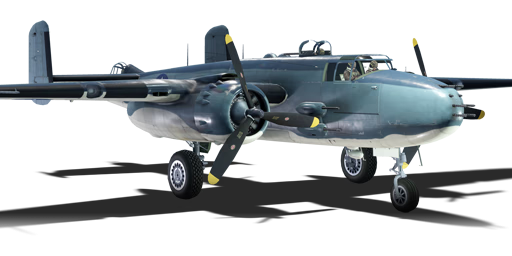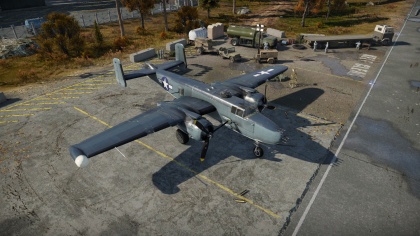PBJ-1J
Contents
| This page is about the aircraft PBJ-1J. For similar vehicles in the airframe family, see B-25 (Family). |
Description
The PBJ-1J is a rank III USA attacker
with a battle rating of 4.0 (AB/SB) and 3.7 (RB). It was introduced in Update 1.41.
General info
Flight Performance
Describe how the aircraft behaves in the air. Maximum speed, manoeuvrability, speed and allowable loads - these are the most important characteristics of the vehicle.
| Characteristics | |||||||
|---|---|---|---|---|---|---|---|
| Stock | |||||||
| Max Speed (km/h at 5,800 m) |
Max altitude (meters) |
Turn time (seconds) |
Rate of climb (meters/second) |
Take-off run (meters) | |||
| AB | RB | AB | RB | AB | RB | ||
| 433 | 420 | 5800 | 37.9 | 38.9 | 4.1 | 5.3 | 850 |
| Upgraded | |||||||
| Max Speed (km/h at 5,800 m) |
Max altitude (meters) | Turn time (seconds) | Rate of climb (meters/second) |
Take-off run (meters) | |||
| AB | RB | AB | RB | AB | RB | ||
| ? | 457 | 5800 | ??.? | 36.0 | ??.? | 7.7 | 850 |
Details
| Features | ||||
|---|---|---|---|---|
| Combat flap | Take-off flap | Landing flap | Air brakes | Arrestor gear |
| ✓ | ✓ | ✓ | X | X |
| Limits | ||||
|---|---|---|---|---|
| Wing-break speed (km/h) |
Gear limit (km/h) |
Combat flap (km/h) |
Max Static G | |
| + | - | |||
| 0 | 294 | 340 | ~4 | ~2 |
| Optimal velocities | |||
|---|---|---|---|
| Ailerons (km/h) |
Rudder (km/h) |
Elevators (km/h) |
Radiator (km/h) |
| < 300 | < 270 | < 350 | > 240 |
| Compressor (RB/SB) | ||
|---|---|---|
| Setting 1 | ||
| Optimal altitude | 100% Engine power | WEP Engine power |
| 524 m | 3,000 hp | 3,339 hp |
| Setting 2 | ||
| Optimal altitude | 100% Engine power | WEP Engine power |
| 3,700 m | 2,700 hp | 3,005 hp |
Survivability and armour
- 8 mm Steel - Lower nose armour plate
- 8 mm Steel - Pilot and Co-pilot's seats
- 9.5 mm Steel - Fore cockpit armour plate
- 9.5 mm Steel - Side armour cockpit plates
- 9.5 mm Steel - Cockpit rear plate
- 9.5 mm Steel - Dorsal gunner aft plate
- 6.35 mm Steel - Side gunners armour plate x 2
- 9.5 mm Steel - Tail gunner protective armour plate
- 12 mm Bulletproof glass - Dorsal gunner turret
- 38 mm Bulletproof glass - Tail gunner canopy
Armaments
Offensive armament
The PBJ-1J is armed with:
- 8 x 12.7 mm M2 Browning machine gun, nose-mounted (400 rpg = 3,200 total)
- 4 x 12.7 mm M2 Browning machine gun, cheek-mounted (400 rpg = 1,600 total)
Suspended armament
The PBJ-1J can be outfitted with the following ordinance:
- Without load
- 12 x 100 lb AN-M30A1 bombs (600 lb total)
- 8 x 250 lb AN-M57 bombs (2,000 lb total)
- 4 x 500 lb AN-M64A1 bombs (2,000 lb total)
Defensive armament
The PBJ-1J is defended by:
- 2 x 12.7 mm Browning M2 machine gun, dorsal turret (400 rpg = 800 total)
- 2 x 12.7 mm Browning M2 machine gun, ventral turret (600 rpg = 1,200 total)
- 1 x 12.7 mm Browning M2 machine gun, 2 x beam turret (250 rpg)
Usage in battles
The PBJ-1J is the U.S. Navy version of the B-25J-1 Mitchell, however, these aircraft were assigned to U.S. Marine Corps marine bomber squadrons (VMB) as land-based bombers or ground attackers. This aircraft is virtually identical to its cousin, the PBJ-1H Mitchell, which is also just ground attack variant of the U.S. Army Air Corps/U.S. Air Force B-25 Mitchell bomber. The only notable difference between the 1H and 1J model aircraft is that the 1J removes the 75 mm cannon and replaces it with an additional 4 x 12.7mm Browning machine guns in the nose. Otherwise the same strategy and tactic for the 1H apply to the 1J. Fly almost at treetop levels in order to demotivate high altitude fighters from diving on you, and attack enemy ground targets. Ensure to use ground targets belts in order to maximize the effectiveness against light and medium tanks. Keep in mind that medium tanks will require precise aiming at the rear armour or roof from optimal angles in order to be effective. Reserve bombs for targets the 1J's machine guns under any circumstance cannot deal with (like heavy tanks and pillboxes, this is especially critical in Realistic and simulator battles as it is necessary to land on an airfield in order to retrieve new bombs).
While the PBJ can be effective at engaging other bombers, only engage enemy fighters if a good opportunity appears where an enemy is already engaged with another plane or is in low energy state (like stalling, taking off or landing). In these situations, the twelve 12.7mm machine guns will make short work of virtually all single-engined fighter aircraft even at long range with ground target belts. That said, under no circumstances should the plane be used to actively pursue enemy fighters since any remotely competent pilot will be able to outmanoeuvre you once they become aware of your presence. Ideally, a PBJ-1J should operate in close proximity to friendly fighters who can support it if it is engaged.
Manual Engine Control
| MEC elements | ||||||
|---|---|---|---|---|---|---|
| Mixer | Pitch | Radiator | Supercharger | Turbocharger | ||
| Oil | Water | Type | ||||
| Controllable | Controllable | Not controllable | Controllable | Combined | Controllable | Not controllable |
Modules
The recommended modules to go in weaponry are the SBC-25 and MBC-25. Which allows for mounting of 250 lb and 500 lb bombs respectively.
| Tier | Flight performance | Survivability | Weaponry | ||
|---|---|---|---|---|---|
| I | Fuselage Repair | Radiator | Protective Vest | Offensive 12 mm | SBC-25 |
| II | Compressor | Airframe | New 12 mm MGs | MBC-25 | |
| III | Wings Repair | Engine | Turret 12 mm | ||
| IV | Engine Injection | Cover | New 12 mm MGs (Turret) | ||
Pros and cons
Pros:
- AP ammo is able to destroy medium and light tanks, as well as light pillboxes
- Excellent defensive firepower, utilizing most of the B-25 Mitchell's gun positions
- Durable airframe which can withstand numerous hits before going down
- Tricycle landing gear makes takeoff and landing easier
- Large ammo capacity
- A staggering 12 x 12.7mm Browning machine guns all fuselage mounted, providing excellent firepower at any range against soft targets
Cons:
- Bombload is limited compared to B-25 Mitchell
- Poor energy retention
- Poor turn and climb rate
- Slow top speed and acceleration both in level flight and in dives
- Twin tails create blindspot for gunners, a trait carried by the B-25 Mitchell
- The added four 12.7 mm machine guns hardly make up for the lack of a 75 mm cannon like on the 1H variant
- Stock model M2 which lacks advanced ammo belt options, making it inadequate at virtually everything
History
The name breakdown: PBJ-1J = Patrol Bomber J (J is the designation for the builder North American), -1 (1st variant), J model.
In-game description
"North American PBJ-1J Mitchell twin-engine torpedo bomber/anti-submarine warfare patrol aircraft
In addition to the USAAF's army aviation, В-25s of various versions were also used by American naval aviation, both in the USN's aviation forces and in the US Marine Corps, under the designation PBJ-1.
The version code usually coincided with the USAAF's code. For example, the В-25J bomber was re-designated the PBJ-1J. There were two exceptions to this rule: the В-25В was named just the PBJ-1, and the PBJ-1G was a torpedo bomber based on the В-25С or the B-25D (since the B-25G version was never in service with naval aviation forces).
So, the PBJ-1J generally corresponded to the B-25J bomber; only its radio equipment differed from that of the army machine.
The aircraft used for anti-submarine patrolling were often equipped with an AN/APS-2 radar scanner (AN/APS-3 later), whose antenna was located under the fuselage in the extendable housing, in the area of the lower turret. The antenna would extend into the air and be withdrawn before landing. There were also machines with AN/APS-3 radar housing protruding out of the upper section of the bombardier/navigator's cockpit or located on the right wing tip.
Some PBJ-1J bombers were produced with the AN/APS-3 radar mounted in a container in the right wing panel. But the mounting of a radar antenna in the aircraft's forward fuselage was considered better by the USMC's aviation units, and so the Marines often shifted it to the nose section on their own.
The combat load of Navy Mitchells included torpedoes and depth bombs. Ten PBJ-1J aircraft from Squadron VMB-12 could carry two 292 mm Tiny Tim unguided air-to-ground rockets under their fuselage.
All naval PBJ-1s operated only from land-based airfields.
Navy PBJ-1s entered service with the USN's aviation fighting units in March 1943. The planes were used for the first time in combat in December 1943, on the island of Espiritu Santo, as anti-submarine warfare patrol aircraft.
The USMC began to use PBJ-1s in March 1944. Marine Corps PBJ-1s participated in the Battles of the Philippines, Saipan, Iwo Jima, and Okinawa. 15 USMC squadrons armed with PBJ-1 aircraft took part in military operations.
A total of 706 PBJ-1 aircraft were built for naval aviation forces, including 255 PBJ-1Js (J-11, J-17, J-22, J-27, J-32, and J-37 production series)."
Media
An excellent addition to the article will be video guides, as well as screenshots from the game and photos.
See also
Links to the articles on the War Thunder Wiki that you think will be useful for the reader, for example:
- reference to the series of the aircraft;
- links to approximate analogues of other nations and research trees.
External links
Paste links to sources and external resources, such as:
- topic on the official game forum;
- encyclopedia page on aircraft;
- other literature.
| USA strike aircraft | |
|---|---|
| Douglas | A-20G-25 · A-26B-10 · A-26B-50 · A2D-1 · AD-2 · AD-4 · A-1H |
| North American | A-36 · PBJ-1H · PBJ-1J |
| Other | AM-1 · AU-1 · XA-38 |





